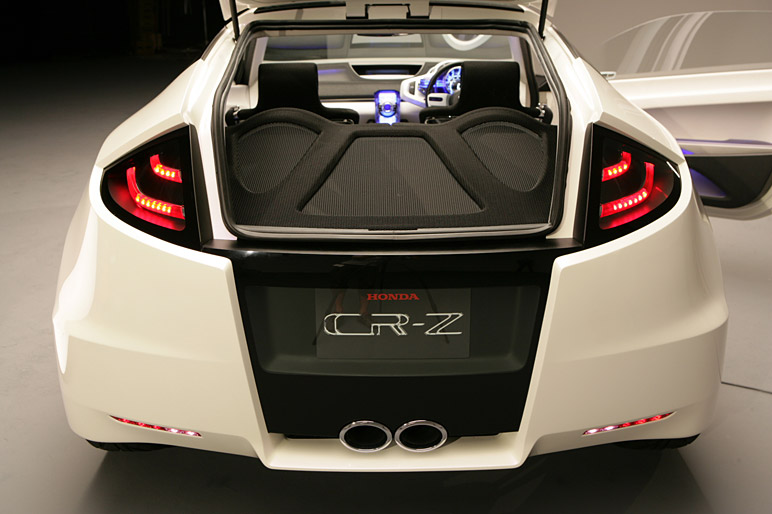Honda CR-Z Hybrid Coupe Test
 The Honda CR-Z is a compact hybrid electric automobile manufactured by Honda and marketed as a "sport hybrid coupe." The CR-Z combines a hybrid gasoline-electric power-train with traditional sports car elements. The CR-Z is regarded as the spiritual successor to the second generation Honda CR-X in both name and exterior design.
The Honda CR-Z is a compact hybrid electric automobile manufactured by Honda and marketed as a "sport hybrid coupe." The CR-Z combines a hybrid gasoline-electric power-train with traditional sports car elements. The CR-Z is regarded as the spiritual successor to the second generation Honda CR-X in both name and exterior design. The basic concept of CR-Z is said to create a fun-to-drive sports car driving characteristics Honda aspired from that of the Elise, as well as the Mini and Volkswagen Scirocco. In a video, Torikai, the chief chassis engineer of CR-Z, explained that during the development process “this car was brought to Europe at each prototype stage to be tested under various road conditions to evaluate whether the desired performance had been achieved.”
The basic concept of CR-Z is said to create a fun-to-drive sports car driving characteristics Honda aspired from that of the Elise, as well as the Mini and Volkswagen Scirocco. In a video, Torikai, the chief chassis engineer of CR-Z, explained that during the development process “this car was brought to Europe at each prototype stage to be tested under various road conditions to evaluate whether the desired performance had been achieved.” Japanese fuel economy ratings are 4.0 litres per 100 kilometres (59 mpg-US) for CVT and 4.4 litres per 100 kilometres (53 mpg-US) for MT in 10•15 mode; and 4.4 litres per 100 kilometres (53 mpg-US) for CVT and 4.9 litres per 100 kilometres (48 mpg-US) for MT in JC08 mode.
Japanese fuel economy ratings are 4.0 litres per 100 kilometres (59 mpg-US) for CVT and 4.4 litres per 100 kilometres (53 mpg-US) for MT in 10•15 mode; and 4.4 litres per 100 kilometres (53 mpg-US) for CVT and 4.9 litres per 100 kilometres (48 mpg-US) for MT in JC08 mode.The 2011 CR-Z U.S. EPA ratings are 31 miles per US gallon (7.6 L/100 km; 37 mpg-imp) for city and 37 miles per US gallon (6.4 L/100 km; 44 mpg-imp) for highway with manual transmission. The model with CVT transmission has a rating of 35 miles per US gallon (6.7 L/100 km; 42 mpg-imp) for city driving cycle and 39 miles per US gallon (6.0 L/100 km; 47 mpg-imp) for highway.
When comparing fuel economy to the CR-Z's older cousin, according to fueleconomy.gov, the 1988 gasoline-powered Honda CR-X HF had an EPA rating of 50 miles per US gallon (4.7 L/100 km; 60 mpg-imp) for city driving and 56 miles per US gallon (4.2 L/100 km; 67 mpg-imp) for highway. However, according to EPA's 2008 revised procedures, the CR-X rating is 41 miles per US gallon (5.7 L/100 km; 49 mpg-imp) city driving, and 49 miles per US gallon (4.8 L/100 km; 59 mpg-imp) highway driving.
It is ranked number four on 2011 EPA top ten list of fuel efficient vehicles for CVT equipped model and number ten for manual transmission equipped model.
 The CR-Z is powered by a 1.5 L (92 cu in) i-VTEC SOHC inline-4 engine, designated as LEA, with Honda's Integrated Motor Assist (IMA) hybrid-electric system. A six-speed manual transmission is standard equipment and a continuously variable transmission (CVT) is available. The system delivers a combined peak output of 122 bhp (91 kW) at 6000 rpm and 128 lb·ft (174 N·m) at 1000 to 1500 rpm (123 lb·ft (167 N·m) on CVT-equipped models). The gasoline motor itself contributes only 111 bhp (83 kW) at 6000 rpm and 106 lb·ft (144 N·m) at 4800 rpm. An early road test of a Japanese-market CR-Z resulted in 0-60 in 10.5 seconds and the quarter mile in 17.6 seconds. Inside Line performed the same 0-60 test in 8.8 seconds, and Motor Trend, in 8.3 seconds.
The CR-Z is powered by a 1.5 L (92 cu in) i-VTEC SOHC inline-4 engine, designated as LEA, with Honda's Integrated Motor Assist (IMA) hybrid-electric system. A six-speed manual transmission is standard equipment and a continuously variable transmission (CVT) is available. The system delivers a combined peak output of 122 bhp (91 kW) at 6000 rpm and 128 lb·ft (174 N·m) at 1000 to 1500 rpm (123 lb·ft (167 N·m) on CVT-equipped models). The gasoline motor itself contributes only 111 bhp (83 kW) at 6000 rpm and 106 lb·ft (144 N·m) at 4800 rpm. An early road test of a Japanese-market CR-Z resulted in 0-60 in 10.5 seconds and the quarter mile in 17.6 seconds. Inside Line performed the same 0-60 test in 8.8 seconds, and Motor Trend, in 8.3 seconds.


No comments:
Post a Comment